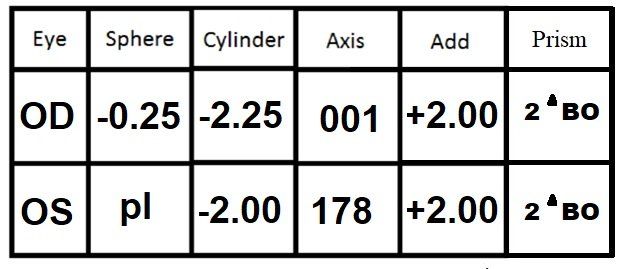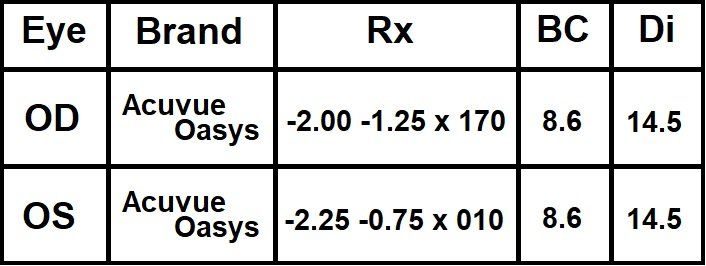Eyeglass Prescription
An eyeglass prescription may seem pretty complex to those that are unfamiliar with them. Shown is an example of how an eyeglass prescription is commonly written. We will take its complexity here and make it simple.
- Eye-in this column "OD" represents the right eye and "OS" represents the left eye
- Sphere-this particular column indicates whether the correction corrects for far-sightedness (+), near-sightedness (-) or has no correction (pl)
- Cylinder-in this column it indicates the cylinder power used to correct for astigmatism
- Axis-the orientation of the cylinder power is given in this column (cylinder powers are 90 degrees apart, the axis is always between 0 and 180 degrees)
- Add-the add indicates the power the eye doctor wants in a bifocal (typically between +1.00 and +3.00), it is an "addition" over the distance correction
- Prism-for patients that experience double vision prism is prescribed to help bring the eyes into alignment, it is designated as a power and has a direction

Soft Contact Lens Prescription
A contact lens prescription is similar to an eyeglass prescription. However, they have some significant differences. These differences are discussed below:
- Brand-soft contact lenses should always include a brand, common brands include Acuvue Oasys, Total 30, Biofinity and Ultra
- Rx-a contact lens prescription is usually a little different than an eyeglass prescription; these differences are due to the available parameters contacts are manufactured in, adjustments for how the contact lens fits and adjusting for the fact that contacts rest on the eye
- BC-the BC stands for base curve, it is measurement of the curve the contact is manufactured with, it may vary between brands and designs
- Di-this is a measurement of the overall diameter of the contact lens in millimeters
